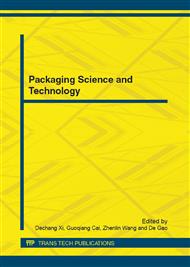p.104
p.109
p.114
p.118
p.122
p.126
p.131
p.136
p.143
Some Observations on Dynamical Cushioning Property of Overlay Cushion Combined with Dissimilar Materials
Abstract:
Honeycomb fiberboard, polyethylene foam, and polystyrene foam were used to manufacture overlay cushion. The corresponding dynamical cushioning property was investigated including the effects the overlay sequence, drop height, join mode, and the thickness difference of both buffer layers. The results indicated the overlay cushion kept a relative high cushioning property when the “soft” buffer layer was directly contacted with the impact rammer. However, the result may be in reverse without adhesion. At the same time, the excessive difference of cushioning property between both the buffer layers was not beneficial to exertion of overlay cushion. Besides, this difference would be scaled up with increase of thickness difference of both the buffer layers.
Info:
Periodical:
Pages:
122-125
Citation:
Online since:
October 2012
Authors:
Keywords:
Price:
Сopyright:
© 2012 Trans Tech Publications Ltd. All Rights Reserved
Share:
Citation:


